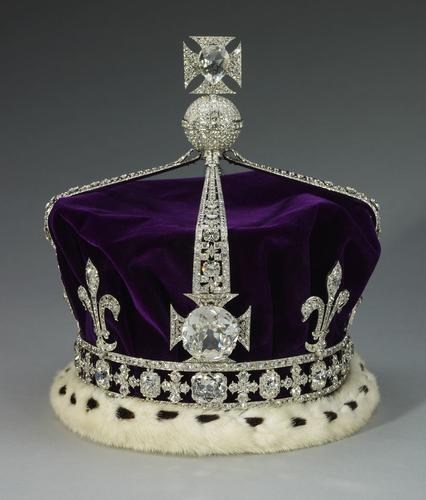Queen Elizabeth The Queen Mother's Crown 1937
Platinum, diamonds, rock crystal, velvet, ermine | 20.7 cm (whole object) | RCIN 31703
-
The crown has a platinum frame set with 2,800 diamonds, mainly cushion-shaped but with some rose-cut and some brilliant-cut. The band, comprising alternating clusters formed as crosses and rectangles, is bordered with single rows of brilliant-cut diamonds and set at the front with a large diamond, which was given to Queen Victoria in 1856 by the Sultan of Turkey. Above the band are four fleurs-de-lis and four crosses-pattée. The front cross holds the Koh-i-nûr diamond in a detachable platinum mount. The four tapering half-arches are removable, and are surmounted by a pavé-set monde and a cross, set with a rock-crystal replica of the Lahore Diamond (presented to Queen Victoria by the East India Company in 1851). Fitted with a purple velvet cap and ermine band.
This crown was made in 1937 for Queen Elizabeth, consort of King George VI, using many stones already in the collection. Most of the diamonds were removed from Queen Victoria's Regal Circlet. The Koh-i-nûr diamond had been successively mounted in the crowns of Queen Alexandra and Queen Mary. The Turkish diamond was a gift from Sultan Abdul Medjid to Queen Victoria in 1856 as a gesture of gratitude for British support during the Crimean War.
The Koh-i-nûr (meaning ‘Mountain of Light’ in Persian) is one of the most contested gemstones in history. Following its probable discovery in India in the fifteenth century, the diamond passed between Persian shahs, Afghan kings and Indian emperors, frequently changing hands through bartering and warfare. The first undisputed account describes it set into the glittering ‘Peacock Throne’ of Mughal emperor Shah Jahan, commissioner of the Taj Mahal. It was captured by the Persian emperor, Nader Shah, when he invaded Delhi in 1739.
By 1813 the diamond formed part of the treasury of Sikh ruler Ranjit Singh in the Punjab (now north-western India). When the British expanded into this territory in 1849, they forced his young son, Maharajah Duleep Singh, to sign a treaty renouncing his sovereignty and transferring the region’s assets to the British. This stone was singled out for surrender to Queen Victoria.
The Koh-i-nûr was delivered to Buckingham Palace in 1850. Soon afterwards, Queen Victoria had it recut by Garrards, the Crown Jewellers, to improve its brilliance. In Britain it has been worn only by women, having gained a reputation for bringing bad luck to male owners. Queen Victoria wore it as a bodice brooch, while Queen Alexandra and Queen Mary had it set into their crowns. It was once again reset for this crown.
Queen Elizabeth wore this crown without its arches at the State Openings of Parliament during the reign of King George VI, and again at the coronation of her daughter, Queen Elizabeth II, in 1953.Provenance
The crown was created for Queen Elizabeth for the coronation of King George VI on 12 May 1937.
First displayed privately and by invitation only at Garrards, Albemarle Street, preceding the Coronation, 4-6 May 1937. -
Creator(s)
(designer/maker)Acquirer(s)
-
Medium and techniques
Platinum, diamonds, rock crystal, velvet, ermine
Measurements
20.7 cm (whole object)
19.7 cm (at base of object)
510.0 g (Weight) (whole object)
Category









